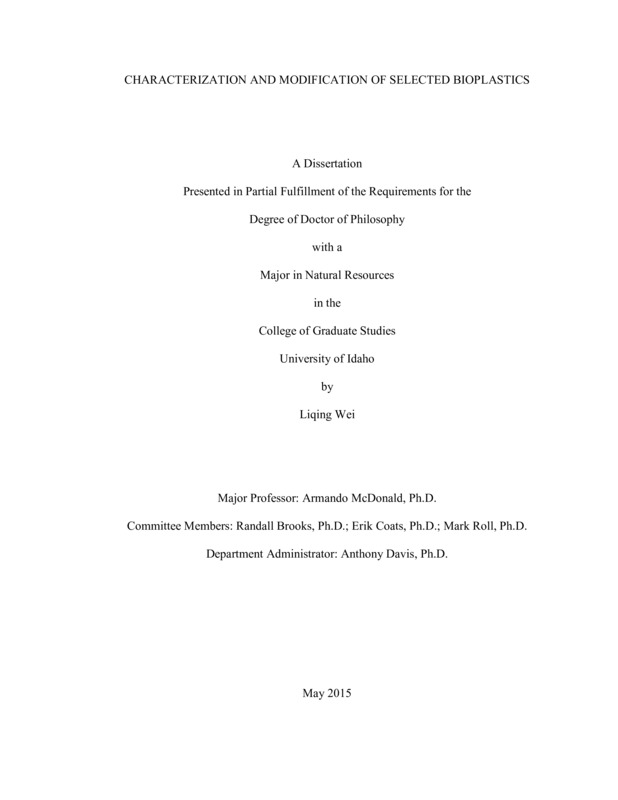Characterization and modification of selected bioplastics
Wei, Liqing. (2015). Characterization and modification of selected bioplastics. Theses and Dissertations Collection, University of Idaho Library Digital Collections. https://www.lib.uidaho.edu/digital/etd/items/wei_idaho_0089e_10532.html
- Title:
- Characterization and modification of selected bioplastics
- Author:
- Wei, Liqing
- Date:
- 2015
- Keywords:
- Bioplastics Cellulose Characterization/Modification Polyhydroxybutyrate Poly(hydroxybutyrate-co-hydroxyvalerate) polylactic acid (PLA)
- Program:
- Natural Resources
- Subject Category:
- Materials Science; Wood sciences; Environmental health
- Abstract:
-
Bioplastics are becoming increasingly prominent mainly due to the growing environmental pollutions caused by non-biodegradable plastics. Polyhydroxybutyrate-co-hydroxyvalerate (PHBV), the major copolymer of polyhydroxyalkanoates (PHAs) family, was biosynthesized (by mixed microbial culture fed with fermented diary manure) and characterized. The monomeric composition (HV% ~ 40%) was determined by GC-MS and NMR. ESI-MSn and NMR analyses showed these PHBVs had random co-monomeric sequence distribution; meantime, they showed characteristic properties (crystallinity, single melting, and tensile properties) as studied by DSC and DMA. The homopolymer poly(3-hydroxybutyrate) (PHB), usually shows interesting properties such as high crystallinity and multiple melting behaviors. The effect of thermal history, such as crystallization (isothermal (temepratures = 80 to 140 ̊C) and nonisothermal (cooling rates = 2 to 50 ̊C/min)) and melting (heating rates = 5 to 50 ̊C/min), on the multiple melting behavior of PHB has been studied using conventional and temperature modulated DSC (TMDSC) techniques. Results showed PHB multiple melting was ascribed to the melting-recrystallization-remelting mechanism and its crystallization kinetics varied with crystallization temperatures and cooling rates. The brittleness and poor melt strength properties of the bioplastics PHB and poly L-lactic acid (PLLA) were imporved by two strategies: (i) to modify polymer structures by cross-linking, (ii) to introduce an external component by grafting, which were initiated by dicumyl peroxide (DCP) via reactive extrusion, have been developed. In method (i), rheological measurements showed cross-linked PHB and PLLA (0.25 to 1 wt% DCP) separately had higher melting strength than their linear polymers due to the formation of long chain branching. Their brittleness was reduced because smaller crystal sizes were observed by hot-stage polarized microscope (HS-POM), meanwhile the reduction of crystallinity was positively correlated to DCP levels. For case (ii), cellulose (another abundant renewable material) was grafted onto PHB backbone induced by DCP (2 to 5 wt%). The chemical structures of grafted copolymer and grafting mechanism were studied by ESR, NMR, XRD and FTIR. Results suggested both amorphous and crystalline regions of cellulose were involved in the reaction. The characterization and modification approaches discussed in this dissertation would provide technical guidance to either researches or industrial processing of these bioplastics.
- Description:
- doctoral, Ph.D., Natural Resources -- University of Idaho - College of Graduate Studies, 2015
- Major Professor:
- McDonald, Armando G
- Committee:
- Brooks,, Randall H; Coats, Erik R; Roll, Mark
- Defense Date:
- 2015
- Identifier:
- Wei_idaho_0089E_10532
- Type:
- Text
- Format Original:
- Format:
- application/pdf
- Rights:
- In Copyright - Educational Use Permitted. For more information, please contact University of Idaho Library Special Collections and Archives Department at libspec@uidaho.edu.
- Standardized Rights:
- http://rightsstatements.org/vocab/InC-EDU/1.0/

